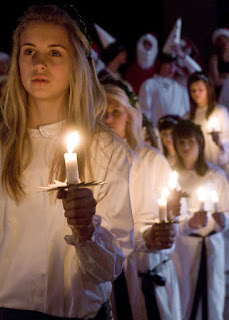Santa Lucia Day (with a Syracuse connection)
Saint Lucy’s Day is celebrated most commonly in Scandinavia, with their long dark winters, where it is a major feast day, and in Italy, with each emphasising a different aspect of the story.
In Scandinavia, where Saint Lucy is called Santa Lucia in Norwegian and Sankta Lucia in Swedish, she is represented as a lady in a white dress and red sash with a crown or wreath of candles on her head. In Norway, Sweden and Swedish-speaking regions of Finland, girls dressed as Lucy carry rolls and cookies in procession as songs are sung.
Christian missionaries arrived in Scandinavia to evangelize the local population, carrying the commemoration of Saint Lucy with them, and this "story of a young girl bringing light in the midst of darkness no doubt held great meaning for people who, in the midst of a North Sea December, were longing for the relief of warmth and light."
The Nordic observation . . . . owes its popularity in the Nordic countries to the extreme change in daylight hours between the seasons in this region. It is said that to vividly celebrate Saint Lucy's Day will help one live the long winter days with enough light.
According to the traditional story, Lucy was born of rich and noble parents about the year 283. Her father was of Roman origin, but died when she was five years old,leaving Lucy and her mother without a protective guardian. St. Lucy, whose name Lucia refers to "light" (Lux, lucis), is believed to have been a Sicilian saint who suffered a sad death in Syracuse, Sicily around AD 310.
from https://en.wikipedia.org/wiki/Saint_Lucy's_Day
Another look at the celebration is found here:
http://www.whychristmas.com/cultures/sweden.shtml
In Scandinavia, where Saint Lucy is called Santa Lucia in Norwegian and Sankta Lucia in Swedish, she is represented as a lady in a white dress and red sash with a crown or wreath of candles on her head. In Norway, Sweden and Swedish-speaking regions of Finland, girls dressed as Lucy carry rolls and cookies in procession as songs are sung.
Christian missionaries arrived in Scandinavia to evangelize the local population, carrying the commemoration of Saint Lucy with them, and this "story of a young girl bringing light in the midst of darkness no doubt held great meaning for people who, in the midst of a North Sea December, were longing for the relief of warmth and light."
The Nordic observation . . . . owes its popularity in the Nordic countries to the extreme change in daylight hours between the seasons in this region. It is said that to vividly celebrate Saint Lucy's Day will help one live the long winter days with enough light.
According to the traditional story, Lucy was born of rich and noble parents about the year 283. Her father was of Roman origin, but died when she was five years old,leaving Lucy and her mother without a protective guardian. St. Lucy, whose name Lucia refers to "light" (Lux, lucis), is believed to have been a Sicilian saint who suffered a sad death in Syracuse, Sicily around AD 310.
from https://en.wikipedia.org/wiki/Saint_Lucy's_Day
Another look at the celebration is found here:
http://www.whychristmas.com/cultures/sweden.shtml





Comments
Post a Comment